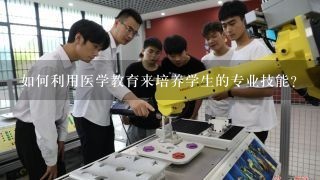如何利用医学教育来培养学生的专业技能?

Answer:
Utilizing Medical Education for Skill Development
1. Clinical Rotations and Internships:
- Provide hands-on experience in clinical settings, allowing students to apply theoretical knowledge in a real-world environment.
- Offer opportunities for internships in hospitals, clinics, research institutions, and other healthcare organizations.
2. Simulation and Role-Playing:
- Utilize simulation software and role-playing techniques to simulate medical scenarios, allowing students to practice coping with real-life situations.
- Encourage teamwork and communication skills in a simulated medical environment.
3. Case-Based Learning:
- Present students with complex medical cases, requiring them to analyze, diagnose, and develop treatment plans.
- Encourage critical thinking, problem-solving, and decision-making skills.
4. Medical Education Technology:
- Integrate virtual reality, augmented reality, and other technology into medical education.
- Provide students with interactive simulations and educational resources.
5. Grand Rounds and Case Conferences:
- Facilitate discussions and case conferences where students can present clinical cases and receive feedback from healthcare professionals.
- Encourage teamwork and communication skills.
6. Mentorship and Peer Learning:
- Pair students with experienced healthcare professionals for mentorship and peer-to-peer learning.
- Foster a collaborative and supportive learning environment.
7. Continuing Education and Professional Development:
- Encourage students to participate in conferences, workshops, and continuing education courses to stay updated on medical advancements.
- Support their professional growth and development.
8. Simulation-Based Training:
- Develop realistic simulations for specific medical procedures, such as surgery, obstetrics, or emergency care.
- Provide students with opportunities to practice and receive feedback in a safe and controlled environment.
9. Patient Education and Communication:
- Integrate patient education into the curriculum, teaching students about medical conditions, treatments, and self-care.
- Encourage communication skills and patient-centered care.
10. Interdisciplinary Collaboration:
- Foster collaboration between different healthcare professionals, such as nurses, doctors, pharmacists, and social workers.
- Encourage students to work in interdisciplinary teams.






































































